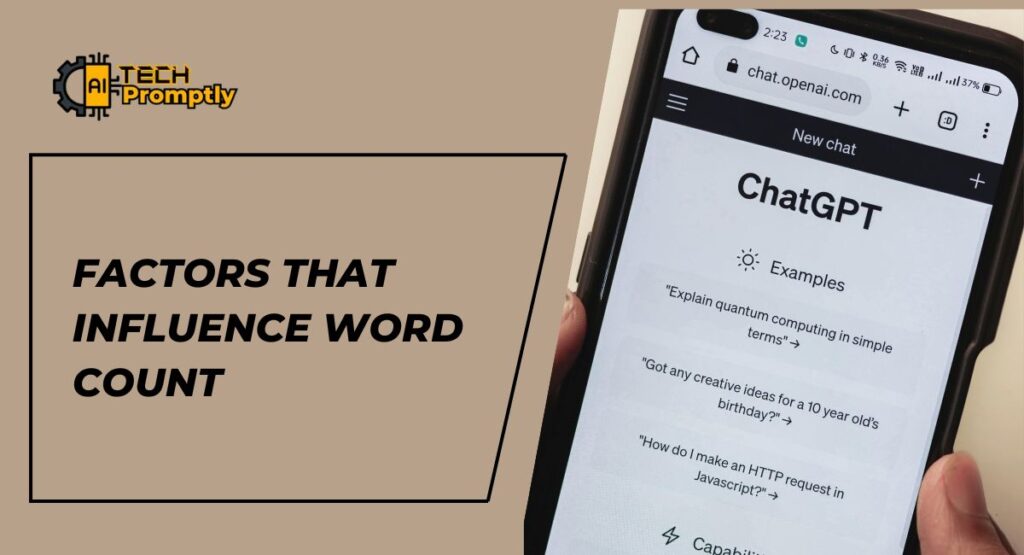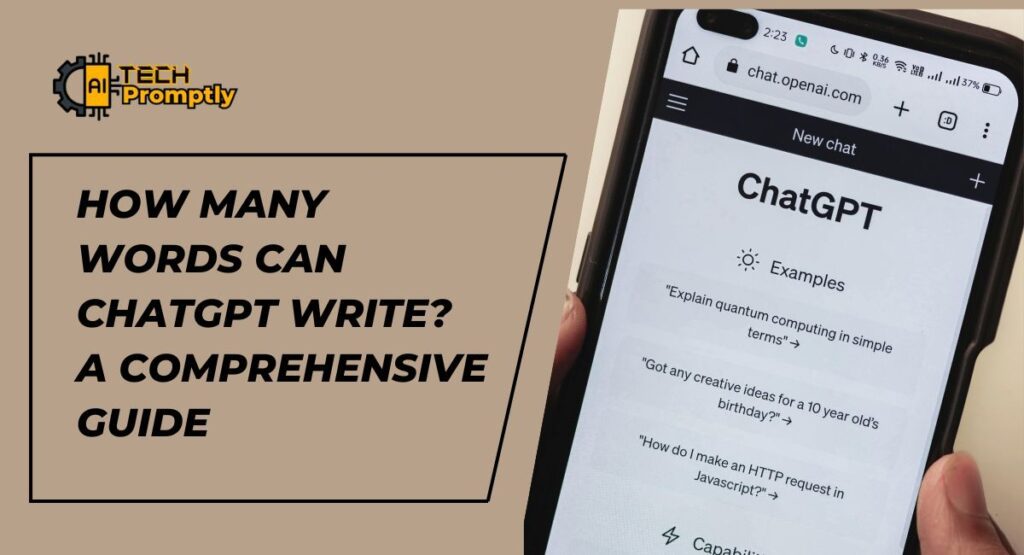In our technologically-driven society, AI tools like ChatGPT have changed the way we create content, deal with questions from customers, and even brainstorm ideas. A frequently asked concerns that people ask is “How many words can ChatGPT write in one go? “ Knowing what features are available and the limits the AI tool is essential whether you are producing code documentation, an article, or the material for a blog.
This article will look at the limitations of words in ChatGPT as well as the elements that affect the performance of the program, and offer suggestions for optimizing output. In the process, we’ll discuss related issues regarding length of content as well as formatting and usage scenarios to provide you with an understanding of how you can get the most of ChatGPT. Learn More with The Ultimate ChatGPT Guide: Tips, Tricks, and Expert Insights for Maximizing AI Potential.
Table of Contents
Understanding How Many Words Can ChatGPT Write: Word Limits
ChatGPT’s capability to write is dependent on its token limit. Tokens are the basic building blocks of AI processing in language, and represent fragments of words. In the context of a sentence, one word is usually translated into 2 or 3 tokens.
- free version (GPT-3.5): The maximum limit for tokens is 496 tokens comprising (input) (input) and the response.
- Pro Version (GPT-4): The limit of tokens is increased up to 8192 tokens and GPT-4 Turbo providing as high as 128,000 tokens in certain cases.
On average, this is equivalent roughly 1500-2500 terms to GPT-3.5 as well as between 3,500 and 4,000 word for GPT-4 in one response. Be aware how long your input impacts the length of output.

Factors That Influence Word Count
- Complexity of the Prompt
If your request requires elaborate or complicated requirements, ChatGPT may produce shorter outputs in order to guarantee consistency and clarity within the limit of tokens. For example, requesting the legality of a contract will require smaller words than requesting the simple story of a creative. - Formatting and Structure
Outputs with bullet points, formatting, or code will typically reduce the word count because tokens are often used to create structural elements. - Prompt Length
A long or detailed request can eat up the limit of tokens which leaves little room to the machine’s reaction. When you are generating longer outputs, make your instructions short. - Repetition and Redundancy
ChatGPT has been designed so as to stop repetition, which could reduce its output. If a repeating response is required (e.g. for mantras or song lyrics) the word count might be greater, but it will not create any new content.

How to Optimize ChatGPT for Longer Outputs
Here are some practical suggestions to increase the number of words ChatGPT can create with the same quality and consistency:
1. Break Down the Task
If you are in need of a lengthy document, think about breaking the content into smaller pieces. Examples:
- First Part “Write an introduction about the history of AI.”
- Second Part: “Describe how artificial intelligence tools are revolutionizing sectors now.”
2. Use Continuation Prompts
If ChatGPT is stopped mid-sentence call it back to continue. Example:
- Your: “Please continue from where you left off.”
This lets you extend the response quickly without compromising flow.
3. Leverage GPT-4 for Larger Outputs
If you are working on projects that require long or more detailed outputs select GPT-4 that has the highest threshold for tokens.
4. Ask for Summaries and Expansions
To go over more To cover more ground, you can ask ChatGPT to provide a summary of one section and then expand on a different one. For instance:
- “Summarize the key features of ChatGPT in 200 words and expand on its applications in education.”

Practical Examples of Word Count Applications
To give you a greater idea of the possibilities ChatGPT can do Here are a few examples of use cases, with estimates of word count:
- Blog Post (1,500 Words)
You can request a full blog post, including subheadings and bullet points, and a FAQ section. Be sure that your instructions guide the AI to concentrate on the issue in a comprehensive manner. - Email Templates (100-300 Words)
ChatGPT excels in making concise email templates that are concise and easy to use. Simply define what tone you want to use, who will be using it and the purpose to get precise results. - Technical Documentation (2,000+ Words)
For tutorials on coding or API guides GPT-4 is the best option. Break down the request into smaller pieces to provide extensive documentation. - Creative Writing (Up to 4,000 Words)
For telling stories, GPT-4 can produce longer creative and imaginative pieces, while maintaining coherence and flow in the narrative.
Common Challenges and How to Overcome Them
Despite its impressive capability, ChatGPT may occasionally fall below expectations. Here’s how you can address the most the most common issues:
- Mid-Response Cutoff
If the response stops If the response is cut off, you can ask the AI to resume. Alternately, reduce your initial input to make space for the output. - Coherence Over Long Outputs
If the piece is very long, ChatGPT might lose track of the context. Separate the content into segments and make clear transitions. - Formatting Issues
For outputs that are structured (e.g. lists, tables) provide formatting information in the prompt. For example: “Provide this information in a table format.”
FAQs About ChatGPT’s Writing Capabilities
1. What is the maximum number of words ChatGPT compose in one response?
ChatGPT is able to write anywhere from 1500-2500 phrases in response to GPT-3.5 as well as up to 4000 word for GPT-4 in one response, based on level of difficulty of the prompt.
2. What happens when the response is interrupted?
You can make a request to ChatGPT to go on. It will continue from the place it left off and continue to flow.
3. Can I utilize ChatGPT to create long-form content such as eBooks?
However, it’s better to break your content in smaller parts and then combine the outputs to ensure coherence.
4. What is what’s the distinction in GPT-3.5 and GPT-4 with respect to the word count?
GPT-3.5 has a limit on tokens of 4,096 tokens. This translates roughly 1,500 to 2,000 words. GPT-4 will handle as many as 8,192 tokens (or more using GPT-4 Turbo) and produce outputs of between 3,500 and 4,000 words.
5. Does ChatGPT compose better when you use an eloquent or precise prompt?
Simple prompts are ideal for longer content, whereas more detailed prompts work best for content that is shorter and focused.
6. Do I have the ability to utilize ChatGPT to help me come up with ideas for material?
Absolutely! ChatGPT is a great tool to brainstorm blog topics, outline or new angles to the content plan.
Conclusion
Knowing the capabilities of ChatGPT’s words allows users to personalize their requirements effectively, whether creating blogs or writing technical documentation or creating compelling emails. With the help of tools like GPT-4 and optimizing your prompts you can expand the limits in what artificial intelligence-generated material could accomplish.
Are you ready to create something truly unique? Start exploring ChatGPT today to discover how it can help you transform the process of creating content! For more join our facebook community. you may read our blog post on Mastering ChatGPT Prompts for Grammar Check: Your Ultimate Guide

